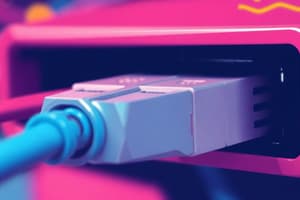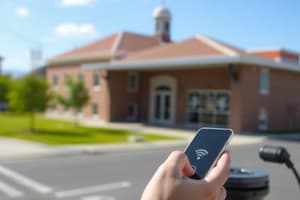Podcast
Questions and Answers
What technology does cable internet service primarily use to deliver high-speed internet access?
What technology does cable internet service primarily use to deliver high-speed internet access?
Cable television networks.
How does the speed of cable internet service typically change when many users are connected simultaneously?
How does the speed of cable internet service typically change when many users are connected simultaneously?
The connection speed decreases.
What equipment is required for DSL internet service to function?
What equipment is required for DSL internet service to function?
A DSL modem.
In what way does a cable modem differ from a traditional broadband modem?
In what way does a cable modem differ from a traditional broadband modem?
What could be a possible limitation of cable internet service in a neighborhood?
What could be a possible limitation of cable internet service in a neighborhood?
What is the primary function of mobile broadband technology on cellular networks?
What is the primary function of mobile broadband technology on cellular networks?
Describe one key difference between mobile broadband and fixed wireless internet connections.
Describe one key difference between mobile broadband and fixed wireless internet connections.
What type of devices can utilize mobile broadband and why is this significant?
What type of devices can utilize mobile broadband and why is this significant?
What kind of transmission is often associated with fixed wireless and what is its purpose?
What kind of transmission is often associated with fixed wireless and what is its purpose?
Explain how fixed wireless internet connects to the internet, mentioning key components involved.
Explain how fixed wireless internet connects to the internet, mentioning key components involved.
Flashcards are hidden until you start studying
Study Notes
Broadband Internet Service Technologies
- Cable Internet Service: High-speed connection through cable television network via a cable modem. Speed decreases if many users are online simultaneously due to shared connection.
- Digital Subscriber Line (DSL): High-speed internet through standard telephone network via a DSL modem.
- Mobile Broadband/Cellular Radio Network: High-speed internet over cellular radio network using compatible technologies (3G, 4G, 5G). Provided by cellular network companies. Works with devices with built-in wireless modems.
- Fixed Wireless: High-speed internet using a dish-shaped antenna on a building. Communicates with a tower location using radio signals. Example: internet connections at hospitals, shopping complexes, and hotels.
- Fiber to the Premises (FTTP): High-speed internet using fiber optic cable via a modem. Fast but expensive and only available in limited areas.
- Satellite Internet Service: Provides high-speed internet access using a satellite dish. Useful in rural areas where other high-speed options are not available. Generally slower and more expensive than cable or DSL.
- Wireless Fidelity (Wi-Fi): High-speed internet connection using broadcast radio signals via a wireless router. Connects directly to an internet modem and acts as a hub to broadcast the signal to devices. Provided by organizations (e.g., shopping malls, restaurants) and offered as hotspots.
Broadband Advantages and Disadvantages
- Advantages:
- Quick downloading and uploading of large files, streaming videos.
- Convenience: Always-on connection.
- Enhanced security options with real-time updates.
- Unlimited access without connection duration charges.
- Disadvantages:
- High cost: Initial setup and monthly fees.
- Technical issues: Installation complexity, maintenance and downtime.
- Security risks: Cyber threats and data breaches due to always-on nature.
2.0 INTERNET TECHNOLOGY
2.6 The Internet Address
- IP address: A sequence of numbers that uniquely identifies the location of each computer or device connected to the internet.
- Purpose of IP address: Used to uniquely identify device locations to send data and information.
- Why we need IP addresses: To uniquely identify devices and enable communication and data exchange.
- IP addressing schemes:
- IPv4: Made up of four groups of decimal numbers, formatted as four 8-bit fields separated by a period (.). Range for each group is from 0 to 255.
- IPv6: Replaces IPv4 due to increase in internet devices and lack of sufficient IPv4 addresses.
Relationship between IP address and domain name:
- Domain name: An easy-to-remember label for a website or server.
- IP address: Numerical address required for communication on the Internet.
- DNS (Domain Name System) translates domain names into associated IP addresses, enabling users to access websites using their names instead of numerical IP addresses.
Studying That Suits You
Use AI to generate personalized quizzes and flashcards to suit your learning preferences.




